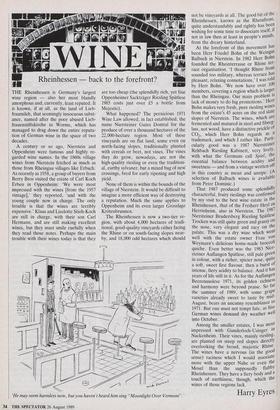ri
IR
- - - •
dill
Rheinhessen — back to the forefront?
THE Rheinhessen is Germany's largest wine region — also her most blandly amorphous and, currently, least reputed. It is known, if at all, as the land of Lieb- fraumilch, that seemingly innocuous subst- ance, named after the poor abused Lieb- frauenstiftskirche in Worms, which has managed to drag down the entire reputa- tion of German wine in the space of two decades.
A century or so ago, Nierstein and Oppenheim were famous and highly re- garded wine names. In the 1860s village wines from Nierstein fetched as much as those from Rheingau villages like Erbach. As recently as 1958, a group of buyers from Berry Bros visited the estate of Carl Koch Erben in Oppenheim: 'We were most impressed with the wines [from the 1957 vintage],' they reported, 'and with the young couple now in charge. The only trouble is that the wines are terribly expensive.' Klaus and Liselotte Stieh-Koch are still in charge, with their son Carl Hermann, and are still making excellent wines, but they must smile ruefully when they read those notes. Perhaps the main trouble with their wines today is that they are too cheap (the splendidly rich, yet fine Oppenheimer Sacktrager Riesling Spatlese 1985 costs just over £5 a bottle from Majestic).
What happened? The pernicious 1971 Wine Law allowed, in fact established, the name Niersteiner Gutes Domtal for the produce of over a thousand hectares of the 22,000-hectare region. Most of these vineyards are on flat land, some even on north-facing slopes, traditionally planted with cereals or beet, not vines. The vines they do grow, nowadays, are not the high-quality riesling or even the tradition- al, earthy sylvaner, but a mixed bag of neNA1 crossings, bred for early ripening and high yield.
None of them is within the bounds of the village of Nierstein. It would be difficult to imagine a more efficient way of destroying a reputation. Much the same applies to Oppenheim and its even larger Grosslage Krotenbrunnen.
The Rheinhessen is now a two-tier re- gion, with about 4,000 hectares of tradi- tional, good-quality vineyards either facing the Rhine or on south-facing slopes near- by, and 18,000 odd hectares which should 'He may seem harmless now, but you haven't heard him sing "Moonlight Over Vermont",' not be vineyards at all. The good bit of the Rheinhessen, known as the Rheinfront, quite understandably and rightly has been wishing for some time to dissociate itself, If not in law then at least in people's minds, from the dreary hinterland. At the forefront of this movement has been Herr Friedel Bohn of the Weingut Balbach in Nierstein. In 1982 Herr Bohn founded the Rheinterrasse or Rhine ter- race organisation. 'I thought Rhine front sounded too military, whereas terrace has pleasant, relaxing connotations,' I was told by Herr Bohn. 'We now have over 100 members, covering a region which is larger than the Rheingau. Our main problem is lack of money to do big promotions.' Herr Bohn makes very fresh, pure riesling wines from the estate's 45 acres on the red slate slopes of Nierstein. The wines, which are fermented and matured in steel and fibreg- lass, not wood, have a distinctive prickle of CO2, which Herr Bohn regards as a trademark, and which I rather like. Parti- cularly good was a 1987 Niersteiner Rehbach Riesling Kabinett, very lively, with what the Germans call Spiel, the essential balance between acidity and sweetness — and from a vintage written off in this country as mean and unripe. (A selection of Balbach wines is available from Peter Dominic.) That 1987 produced some splendid characterful, fruity rieslings was confirmed by my visit to the best wine estate in the Rheinhessen, that of the Freiherr HeY1 ZU Herrnsheim, also in Nierstein. The 1987 Niersteiner Brudersberg Riesling Spatlese Trocken was still quite green and grassy on the nose, very elegant and racy on the palate. This was a dry wine which went well with the estate owner Frau von. Weymarn's delicious home-made broccoli quiche. Even better was the 1983 Nier- steiner Auflangen Spatlese, still pale green in colour, with a richer, spicier nose, quite a soft, sweet first flavour, then a burst of intense, fiery acidity to balance. And it has years of life still in it As for the Auflangen Beerenauslese 1971, its golden richness and harmony were beyond praise. So far the summer of 1989, with some grape varieties already sweet to taste by mid August, bears an uncanny resemblance. to 1971. But one must not tempt fate, as fine German wines demand dry weather well into October.
Among the smaller estates, I was most impressed with Gunderloch-Usinger in Nackenheim. Their vines, mainly riesling, are planted on steep red slopes directly overlooking the broad, majestic Rhine. The wines have a nervous (in the good sense) raciness which I would associate more with the upper Nahe or even the Mosel than the supposedly flabby Rheinhessen. They have a fiery body and a touch of earthiness, though, which the wines of those regions lack.
Harry Eyres










































 Previous page
Previous page